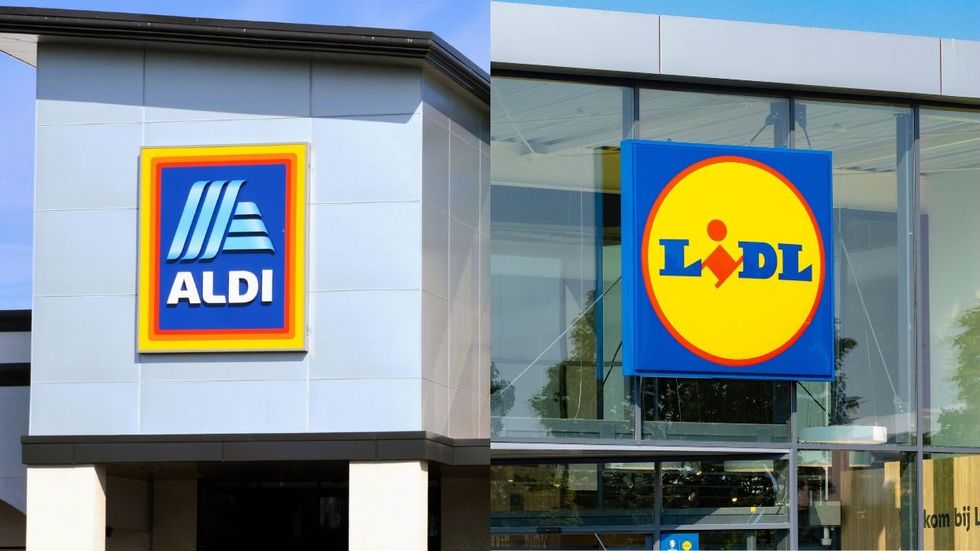It’s no secret that shoppers are frustrated with traditional supermarkets, with some even going so far as to boycott certain chains due to price inflation and food shortages. However, new data proves that discount grocery chains Aldi and Lidl are quietly—and quite masterfully—avoiding such pitfalls and disrupting the American grocery game. In fact, the two German brands are “thriving” in the U.S. and have “firmly established themselves as discount powerhouses,” according to a new report from Placer.ai.
The report, aptly titled “ALDI and Lidl’s Winning Formula,” shows that both grocers are putting up high numbers in 2025 so far. Here’s what that means for you and your weekly grocery run, and how you can shop smarter at both Aldi and Lidl.
RELATED: The 5 Best Household Items to Buy at Aldi
Aldi and Lidl are beating the competition
Aldi and Lidl are outperforming other American grocery chains in overall visits this year.
During the first quarter of 2025, foot traffic at Aldi soared by 8.9%, and Lidl recorded a 4.2% increase compared to last year, according to the report. Average visits per location were also up from 2024, which “highlights that their stores, whether new locations or already-existing ones, are driving sustained demand,” per Placer.ai.
Lidl has been playing the long game, adding new locations across the country at a much slower pace than Aldi. However, its “brand recognition” strategy is paying off: Lidl reported a 1.9% increase in average visits per location in the first quarter of 2025, with customers in suburban areas seeming to like the chain.
“These metrics strongly suggest that Lidl has more demand in the suburbs than it may realize—and as it expands, focusing on these areas might prove to be a winning strategy for the chain,” reads the report.
Aldi is also reaping the benefits of its “five-year national growth strategy.” As wereported in Feb. 2025, “Aldi will open more than 225 new locations this year—getting the company one step closer to reaching its goal of operating 3,200 stores nationwide. Over half of these stores will be brand-new to Aldi’s footprint portfolio, meaning they aren’t remodels (i.e. existing stores needing a facelift) or store conversions. This solidifies the chain’s organic growth model, which has been increasing with consumer demand for years now.”
The proof is in the pudding: The chain’s average visits per location jumped 4.7% during the first quarter of 2025 compared to last year.
Part of Aldi’s national growth strategy includes amping up its presence in Southern California, Arizona, the Northeast, Midwest, and Southeast. In fact, Aldi just launched its first-ever Las Vegas outpost earlier this year.
According to the Placer.ai report, Aldi is on an “ambitious trajectory” that’s boosting its reputation in the national grocery game.
“This consistent growth in visit share underscores the broad appeal of ALDI’s value proposition to shoppers across the country,” the report said.
Why weekends are so popular at the chains
Collectively, both Aldi and Lidl are weekend hot spots among grocery shoppers.
Aldi pulls in 37.2% of the weekend grocery rush, while Lidl is responsible for 37.7%. The remaining 33.4% is fulfilled by a mishmash of other supermarket brands across the U.S.
“This suggests that the attractive price points offered by Aldi and Lidl position them as prime destinations for shoppers making weekend stock-up trips.”
Since their arrival in the U.S., both grocers have been known for their low prices on everyday foods and household items. These days, it seems Americans are taking advantage of those discounts on essentials more than ever.
As the report concluded, “Aldi and Lidl are thriving, growing their audiences during a challenging economic climate.”
RELATED: Grocery Expert Says These Are the 6 Healthiest Potato Chips You Can Buy Right Now
How to shop smarter at Aldi and Lidl
If you’re a weekend warrior or just looking to check out one of these grocers for the first time, here are some hot tips to make the most out of your shopping trip:
- At Aldi, bring a quarter. You’ll need it to unlock a shopping cart, but you’ll get it back when you return it. This is a reason why they can keep prices low and organization high.
- Bring reusable bags. If you don’t have them on hand, be ready to buy paper, plastic, or reusable bags at checkout.
- Both stores offer rotating deals and limited-time items. In these special middle aisles, called “Aldi Finds” or “Lidl Surprises,” you’ll find everything from air fryers to seasonal snacks.
- Most products are from the chains’ in-house labels. Name brands are hard to find, but these private label options are made similarly and often just as good and much cheaper.
- Lidl is known for its fresh in-store bakery. You’ll find affordable pastries, crusty breads, and croissants that rival what you’d find in Europe.
- Download the apps. Aldi’s app helps track weekly deals, and Lidl’s app gives access to digital coupons and a loyalty program that offers free items and discounts.
- Shop organic and international foods. Both chains carry surprisingly robust selections of organic produce, European staples, and special diet items—often at lower prices than competitors.
- Use the return policies. Aldi has a generous one: if you’re unhappy with a product, you can get a refund and replacement. Lidl also has a flexible return window on most products.
Content shared from bestlifeonline.com.

